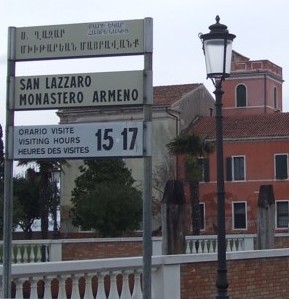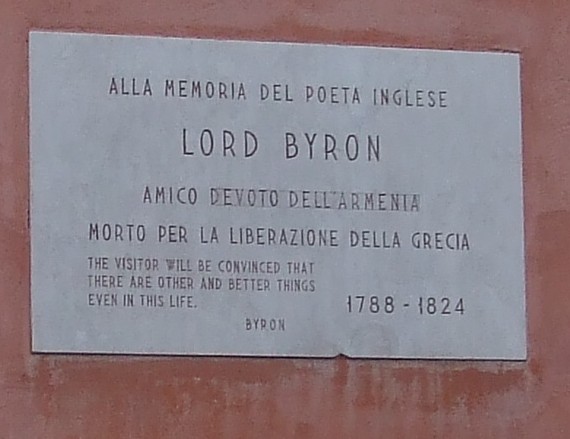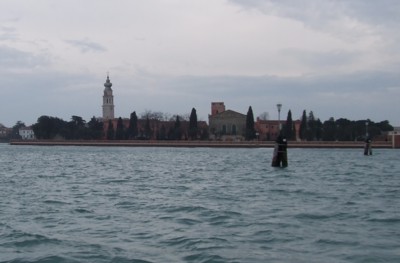The Isola di San Lazzaro degli Armeni is a little island in the Venetian lagoon, between Venice and the Lido. It houses the only local monastery not to be supressed by Napoleon, and today monks from the Armenian order which run the monastery will show you around their buildings.
San Lazzaro tours and travel
Guided tours run just once a day, at 3.25pm (check the latest info online in advance). The tour is conducted in a range of languages. There’s an admission charge.
You will need to take the number 20 ferry which leaves from the San Zaccaria stop along Riva degli Schiavoni at 3:10pm (check the timetable in advance in case of any changes). Allow yourself a few minutes to find the correct stop, as many different services stop at San Zaccaria and there are several boarding jetties.
History of the island
For nearly three centuries the island of San Lazzaro has belonged to the monks of the Armenian Mekhitarist Order (degli Armeni means ‘of the Armenians’). This small island, once a leper colony, was given to the order’s founder Mekhitar in 1717 as he fled with his monks from the Turks. A statue of Mekhitar stands outside. San Lazzaro became a centre for Armenian culture, printing literature in Armenian. When Napoleon closed down the monasteries of Venice and the lagoon, he made an exception for this one.
On San Lazzaro the monks quietly worked away with their printing presses. One of their most glamorous brushes with the outside world was when Lord Byron took an interest in them. In between his Venetian dissipations, the poet felt the need for some intellectual exercise, so he would row out to the island to study Armenian with the monks, and to help them produce an Armenian – English dictionary. The Mekhitarists are still sweetly proud of his interest, and display a portrait of the poet on the wall of the room in which he studied.
Our trip to San Lazzaro

We visited San Lazzaro on a quiet day in late January. There were just a handful of tourists on our boat, all heading for the island. We’d all boarded the ferry at San Zaccaria, pausing to read a little note fixed at the boat stop (by the monks?) advising travellers to visit only at the scheduled time. We got off the ferry on the little jetty, where welcoming signs were displayed in various languages including Armenian.
The nine of us – the others were Italian, Irish and French – milled around uncertainly between the ferry stop and the monastery buildings, where a wall plaque commemorates Byron (‘faithful friend of Armenia’). Then a door in the main building slid open in silent invitation.
Having dutifully paid our admission fee, we were greeted by our guide, a little robed priest in a winter-weight robe and warm slippers. This man of God proved to be one of the most memorable things about our visit, with his dry sense of humour and his manner which combined perkiness with world-weary resignation.
We followed our guide around a cloister which enclosed a small garden and was awash with drifting scents of incense. Inside the monastery’s pretty, mosaic-filled little church, we sat obediently in pews while our nationalities and linguistic abilities were queried. The monks here have always been famous for their linguistic skills, and our guide proceeded to give the entire tour in English, French and Italian, one after the other. It would have been interesting to see how many other languages he could manage on a busy day; something told us that it would be hard to catch him out.
He gave us a potted history of Armenian culture, rightly supposing us to be very ignorant on the subject of this important culture: ‘the first officially Christian country’ among other things. The church here, he observed, was not in the Armenian style (a Greek cross): it was dedicated to St. Erasmus and predated the Armenian presence on the island by many centuries. Having listened to this interesting talk and looked around the church, we continued on our tour around the monastery. We passed the refectory where the monks, whose numbers have sadly dwindled, dine at neatly-laid tables.

Upstairs comes a series of rooms containing the monastery’s treasures. Along with a painting by Tiepolo, these include several rooms of bizarre oddments presented to the monastery over the years. Some of these are rather special, others are just plain strange. Items on show range from Armenian art to an Egyptian mummy. Glass cases contain pipes, porcelain, ivory carvings and all sorts of other curios.
The monastery is famous for its books and a smart new extension houses the impressive library of important volumes, including some fascinating historic works, propped open to be admired.
Is the excursion worthwhile?
If you’re here for a short break and you want to tick Venice’s big attractions off your list, you’ll have already realised that this isn’t the excursion for you. But if you’re staying for a longer holiday, or making a return visit, this is an interesting and unusual outing. It may also send you home determined to consult a map and read up on Armenian history; our guide’s gentle enthusiasm was contagious.
Visiting San Lazzaro
San Lazzaro is most conveniently visited as a short trip from Venice; it combines well with a few hours spent in the St. Mark’s area of the city.You could enjoy afternoon tea at Florian’s before walking to Riva degli Schiavoni for the San Lazzaro ferry, and experience two very different Venetian institutions one after the other. Byron himself, you can reflect, may have made precisely this journey.
On this site
Useful external links
